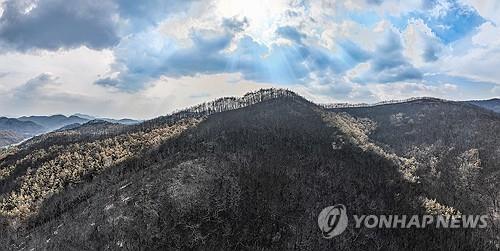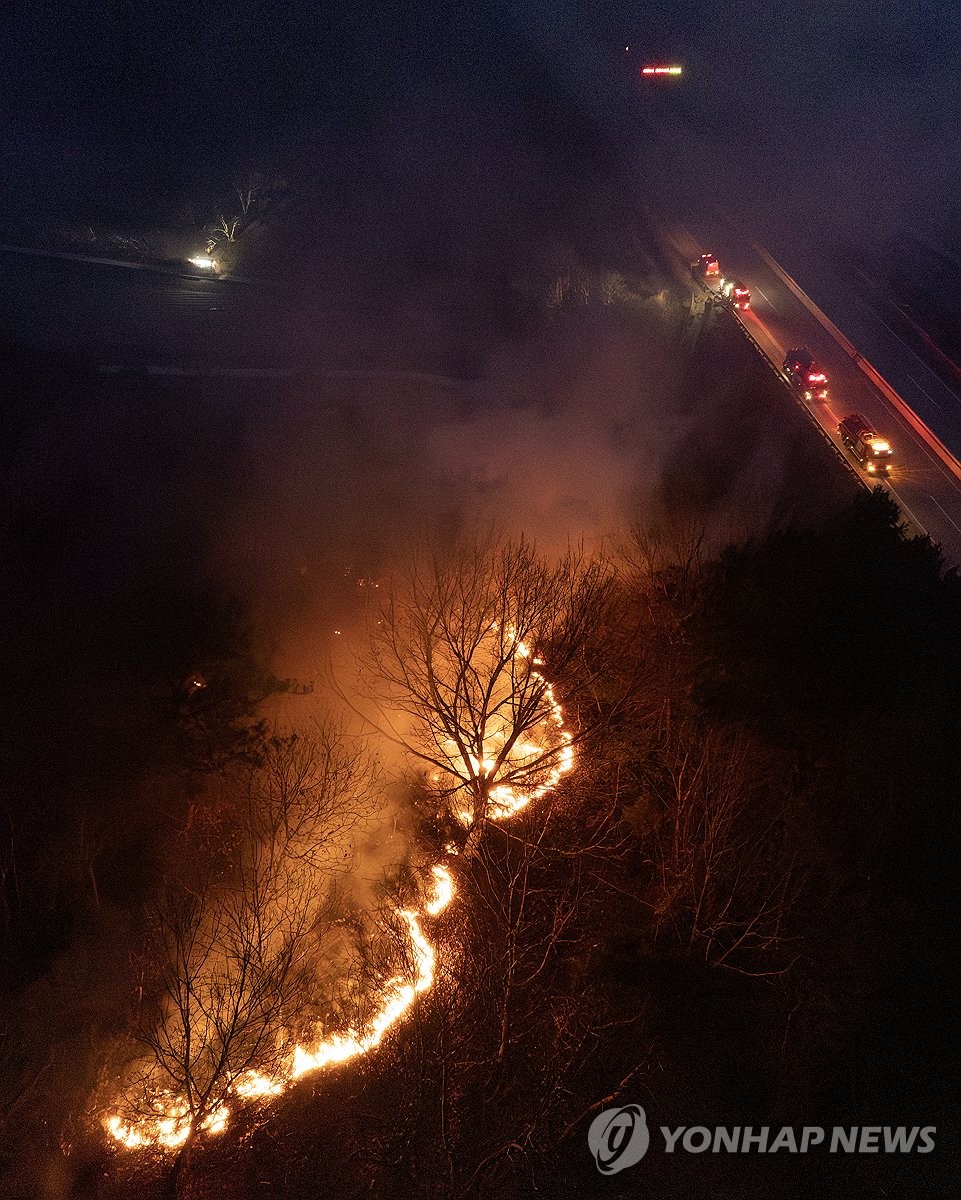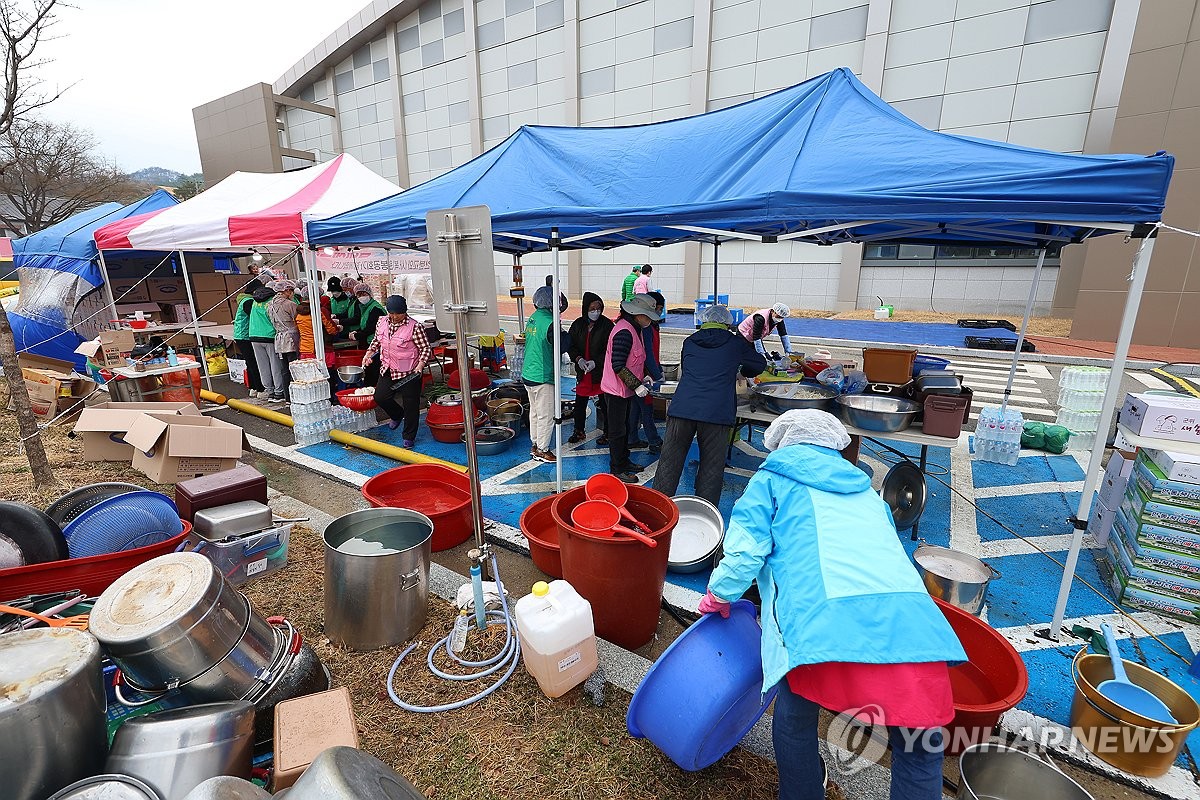(6th LD) Worst-ever wildfires in southeastern S. Korea fully contained, leaving massive damage, causalities
(ATTN: ADDS more details, remarks from 3rd para)
By Yi Wonju
UISEONG, South Korea, March 28 (Yonhap) -- Massive wildfires that ravaged North Gyeongsang Province for a week were fully contained Friday, authorities said, as better visibility and cooler temperatures from overnight rain helped firefighters put out the main blazes.
In South Korea's worst wildfire disaster, a wave of forest fires has devastated the southeastern region, including South Gyeongsang Province since last Friday, killing at least 28 people, injuring 37 and forcing some 38,000 people to flee, according to the government's disaster response agency.

Shafts of sunlight illuminate a mountain burned by fire in the county of Uiseong, North Gyeongsang Province, on March 28, 2025. (Yonhap)
The largest-ever wildfire in North Gyeongsang Province had been fully brought under control by 5 p.m., approximately 149 hours after it first broke out in the county of Uiseong, according to the Korea Forest Service (KFS).
Firefighting authorities are still working to contain fires in South Gyeongsang Province, where, as of 3 p.m., an average of 93 percent of fires across the region had been extinguished.
"Once the main blazes are extinguished, local governments and relevant authorities will focus on fully extinguishing the embers across the region, which is expected to take an additional five to six days," KFS chief Lim Sang-seop said during a press briefing.
In North Gyeongsang Province alone, the disaster has left at least 24 people dead, with around 45,157 hectares of land burned, equivalent to more than 63,000 soccer fields.
Taking the wildfires in both North and South Gyeongsang Provinces together, about 48,000 hectares of woodland have been scorched, roughly 80 percent of the size of Seoul.
It is nearly 25,000 ha more than the 23,794 ha damaged by the east coast wildfires in 2000, which were the worst in the nation's history at the time.

A Chinook helicopter of the Army dumps water on a mountain in Sancheong, South Gyeongsang Province, southeastern South Korea, on March 28, 2025, as firefighting operations continue to bring a wildfire that hit the region under control. (Yonhap)
"Strong and dry winds had swept through the inland regions and quickly spread the fire. High temperatures and dry weather conditions also made the situation worse. We also had difficulties in operating helicopters due to haze," Lim said.
In some signs of relief, rainfall overnight helped firefighters rein in fires and enable them to focus on extinguishing the main blazes in multiple locations.
Some 5,580 personnel, 86 firefighting helicopters and 569 fire trucks were deployed Friday to fully contain the wildfires in Uiseong and other regions in North Gyeongsang Province.
The provincial government has vowed to provide relief grants to residents in the affected regions as soon as possible and to extend other necessary support to help them return to normalcy.
Authorities believe that the wildfires were ignited by human activities.
The fire in Uiseong began when a man was tending to a family grave on a hill, with video footage from the gravesite showing a lighter on the ground.
Local police said they will summon the suspect for questioning on Monday.
Experts have called for an overhaul of the wildfire response system, given the grim reality of global warming.
They have also emphasized the need to secure more equipment and manpower, and to replace fire-prone pine trees with more fire-resistant tree species.

A wildfire continues to burn in a mountainous area along an expressway in Andong, North Gyeongsang Province, southeastern South Korea, on March 27, 2025. (Yonhap)

This photo, taken March 28, 2025, shows a blackened mountainous area that a massive wildfire ripped through for one week in Cheongsong, North Gyeongsang Province, southeastern South Korea, as forestry authorities say it had been 89 percent contained as of 5 a.m. the same day. (Yonhap)

Volunteers prepare to serve hot meals at a sports center used as an evacuation center in Cheongdo, North Gyeongsang Province, southeastern South Korea, on March 28, 2025, for those displaced by a massive wildfire that hit the region. (Yonhap)
julesyi@yna.co.kr
(END)
-
 (LEAD) Kim Soo-hyun expresses regret, denies underage dating allegations
(LEAD) Kim Soo-hyun expresses regret, denies underage dating allegations -
 (Movie Review) Actor-director Ha Jung-woo's 'Lobby' offers satirical insight into 'golf business'
(Movie Review) Actor-director Ha Jung-woo's 'Lobby' offers satirical insight into 'golf business' -
 'The Old Woman With the Knife' breaks ground with female assassin in her 60s
'The Old Woman With the Knife' breaks ground with female assassin in her 60s -
 Netflix's Korean mystery 'Karma' follows six people entangled in messy ties
Netflix's Korean mystery 'Karma' follows six people entangled in messy ties -
 Kim Sae-ron's family releases alleged evidence of underage relationship with Kim Soo-hyun
Kim Sae-ron's family releases alleged evidence of underage relationship with Kim Soo-hyun
-
 (Movie Review) Actor-director Ha Jung-woo's 'Lobby' offers satirical insight into 'golf business'
(Movie Review) Actor-director Ha Jung-woo's 'Lobby' offers satirical insight into 'golf business' -
 Kim Sae-ron's family releases alleged evidence of underage relationship with Kim Soo-hyun
Kim Sae-ron's family releases alleged evidence of underage relationship with Kim Soo-hyun -
 'The Old Woman With the Knife' breaks ground with female assassin in her 60s
'The Old Woman With the Knife' breaks ground with female assassin in her 60s -
 Netflix's Korean mystery 'Karma' follows six people entangled in messy ties
Netflix's Korean mystery 'Karma' follows six people entangled in messy ties -
 (LEAD) Kim Soo-hyun expresses regret, denies underage dating allegations
(LEAD) Kim Soo-hyun expresses regret, denies underage dating allegations
-
 (LEAD) Kim Soo-hyun expresses regret, denies underage dating allegations
(LEAD) Kim Soo-hyun expresses regret, denies underage dating allegations -
 Constitutional Court to rule on Yoon's impeachment Friday
Constitutional Court to rule on Yoon's impeachment Friday -
 Trump says there's 'communication' with N.K. leader Kim
Trump says there's 'communication' with N.K. leader Kim -
 (2nd LD) Constitutional Court to rule on Yoon's impeachment Friday
(2nd LD) Constitutional Court to rule on Yoon's impeachment Friday -
 (3rd LD) Former 3-term lawmaker Chang Je-won found dead amid probe into sexual assault allegations
(3rd LD) Former 3-term lawmaker Chang Je-won found dead amid probe into sexual assault allegations







